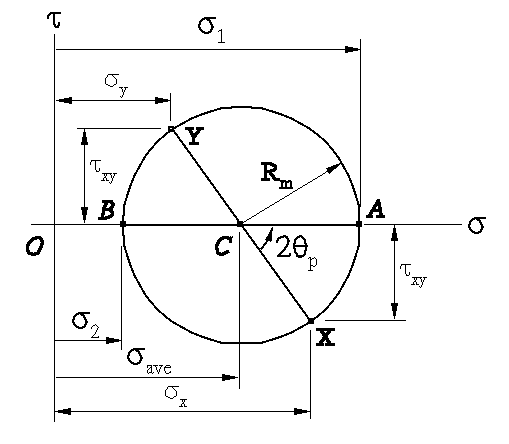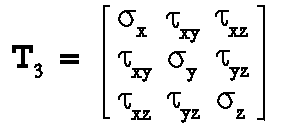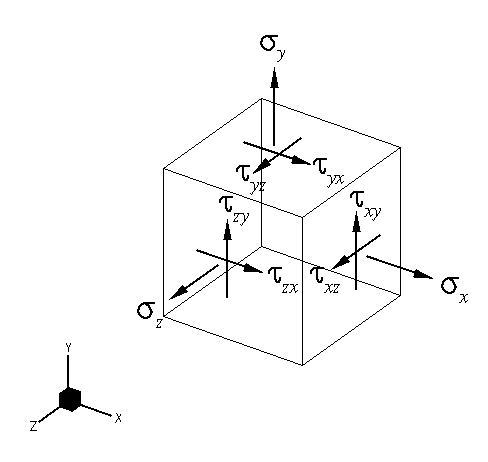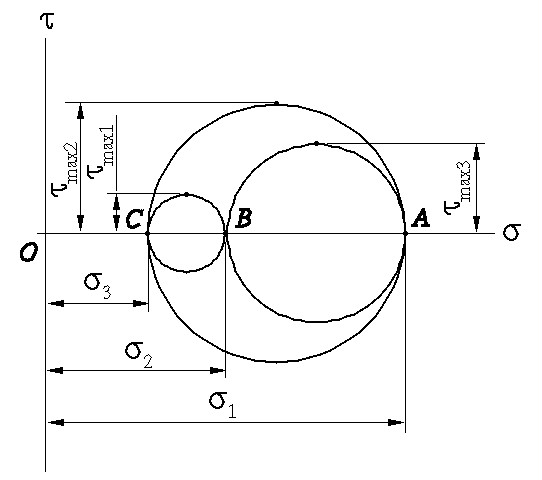Mohr's Circle for 2-D Stress Analysis
If you want to know the
principal stresses and maximum shear stresses, you can simply make it through
2-D or 3-D Mohr's cirlcles!
You can know about
the theory of Mohr's circles from any text books of Mechanics of
Materials. The following two are good references, for examples.
1. Ferdinand P. Beer and E. Russell Johnson, Jr, "Mechanics of Materials",
Second Edition, McGraw-Hill, Inc, 1992.
2 . James M. Gere and Stephen P. Timoshenko, "Mechanics of Materials",
Third Edition, PWS-KENT Publishing Company, Boston, 1990.
The 2-D stresses, so
called plane stress problem, are usually given by the three stress components
sx
, sy
, and txy
, which consist in a two-by-two
symmetric matrix (stress tensor):

(1)
What people usually are
interested in more are the two prinicipal stresses s1
and s2
, which are the two eigenvalues
of the two-by-two symmetric matrix of Eqn (1), and the maximum shear
stress tmax
, which can be calculated from s1
and s2
.
Now, see
the Fig. 1 below, which
represents that a state of plane stress exists at point O and that
it is defined by the stress components sx
, sy
, and txy
associated with the left element in the Fig. 1. We
propose to determine the stress components sxq
,
syq
,
and txyq
associated with the right element after it has
been rotated through an angle q
about the z axis.
 Fig. 1 Plane stresses in different orientations
Fig. 1 Plane stresses in different orientations
Then, we have the following relationship:
sxq
= sx
cos 2 q
+ sy
sin2 q
+ 2 txy
sin q cos q
(2)
and
txyq
= -(sx
- sy
) cos2
q + txy
(cos2 q
- sin2 q)
(3)
Equivalently, the above
two equations can be rewritten as follows:
sxq
= (sx
+
sy)/2
+ (sx
-
sy)/2
cos 2q + txy
sin 2q
(4)
and
txyq
= -(sx
-
sy)/2
sin 2q + txy
cos 2q
(5)
The expression for the normal stress syq
may
be obtained by replacing the q
in the relation
for sxq
in
Eqn. 3 by q
+ 90o ,
it turns out to be
syq
= (sx
+
sy)/2
- (sx
-
sy)/2
cos 2q - txy
sin 2q
(6)
From the relations for sxq
and
syq
, one obtains the circle
equation:
(sxq
- save)2
+ t2xyq
= R2m
(7)
where
save
= (sx
+
sy)/2
= (sxq
+
syq)/2
;
Rm
= [(sx
-
sy)2
/ 4 + t2xy]1/2
(8)
This circle is with radius
R2m
and centered at C
=
(save
, 0)
if
let s = sxq
and t
= -txyq
as shown
in Fig. 2 below - that is right the Mohr's Circle
for plane stress problem
or 2-D stress problem!
 Fig. 2 Mohr's circle for plane (2-D) stress
In fact, Eqns. 4 and 5
are the parametric equations for the Mohr's circle! In Fig.
2, one reads that the point
Fig. 2 Mohr's circle for plane (2-D) stress
In fact, Eqns. 4 and 5
are the parametric equations for the Mohr's circle! In Fig.
2, one reads that the point
X = (sx
, -txy
)
(9)
which corresponds to the
point at which q = 0 and
the point
A = (s1
, 0 )
(10)
which corresponds to the
point at which q = qp
that gives the principal stress s1
! Note that
tan 2qp
= 2txy
/(sx
-
sy)
(11)
and the point
Y = (sy
, txy
)
(12)
which corresponds to the
point at which q = 90o
and the
point
B = (s2
, 0 )
(13)
which corresponds to the
point at which q = qp
+ 90o
that gives
the principal stress s2
! To this end, one
can pick the maxium normal stressess as
smax
= max(s1
, s2),
smin
= min(s1
, s2)
(14)
Besides, finally one can also read the maxium shear stress
as
tmax
= Rm =
[(sx
-
sy)2
/ 4 + t2xy]1/2
(15)
which corresponds to the
apex of the Mohr's circle at which q = qp
+ 45o
!
(The end.)
Mohr's Circles for 3-D Stress Analysis
The 3-D stresses, so called
spatial stress problem, are usually given by the six stress components
sx
, sy
, sz
, txy
, tyz
, and tzx
, (see Fig. 3) which consist in a three-by-three
symmetric matrix (stress tensor):

(16)
What people usually are
interested in more are the three prinicipal stresses s1
, s2
, and s3
, which
are eigenvalues of the three-by-three symmetric matrix of Eqn (16)
, and
the three maximum shear stresses tmax1
, tmax2
, and tmax3
, which
can be calculated from s1
, s2
, and s3
.
 Fig. 3 3-D stress state represented by axes
parallel to X-Y-Z
Fig. 3 3-D stress state represented by axes
parallel to X-Y-Z
Imagine that there
is a plane cut through the cube in Fig. 3 , and the unit normal vector
n
of the cut plane has the direction cosines vx
, vy , and vz
, that is
n = (vx
, vy
, vz)
(17)
then the normal stress
on this plane can be represented by
sn
= sxv2x
+ syv2y
+ szv2z
+ 2 txyvxvy
+ 2 tyzvyvz
+ 2 txzvxvz
(18)
There exist three sets
of direction cosines, n1,
n2,
and n3
- the three principal axes, which make sn
achieve extreme
values s1 ,
s2 ,
and s3 -
the three principal stresses, and on the corresponding cut planes, the
shear stresses vanish! The problem of finding the principal stresses
and their associated axes is equivalent to finding the eigenvalues and
eigenvectors of the following problem:
(sI3
- T3)n =
0
(19)
The three eigenvalues
of Eqn (19) are the roots of the following characteristic polynomial
equation:
det(sI3
- T3) = s3
- As2
+ Bs - C =
0
(20)
where
A = sx
+ sy
+ sz
(21)
B = sxsy
+ sysz
+ sxsz
- t2xy
- t2yz
- t2xz
(22)
C = sxsysz
+ 2 txytyztxz
- sxt2yz-
syt2xz-
szt2xy
(23)
In fact, the coefficients
A, B, and C in Eqn (20) are invariants as long as the stress state is prescribed(see
e.g. Ref. 2) . Therefore, if the three roots
of Eqn (20) are s1,
s2 ,
and s3
,
one has the following equations:
s1
+ s2
+ s3
= A
(24)
s1s2
+ s2s3
+ s1s3
= B
(25)
s1s2s3
= C
(26)
Numerically, one can always find one of the three roots of
Eqn (20) , e.g. s1
, using line search algorithm, e.g. bisection
algorithm. Then combining Eqns (24)and (25), one obtains a simple
quadratic equations and therefore obtains two other roots of Eqn (20),
e.g. s2
and s3
. To this end, one can re-order the three
roots and obtains the three principal stresses, e.g.
s1
= max(s1
, s2
, s3)
(27)
s3
= min(s1
, s2
, s3)
(28)
s2
= (A -
s1
- s2
)
(29)
Now, substituting s1
, s2
, or s3
into Eqn (19), one can obtains the corresponding
principal axes n1,
n2,
or n3
, respectively.
Similar to Fig. 3, one can imagine a cube with their
faces normal to n1,
n2,
or n3
. For example, one can do so in Fig. 3 by replacing
the axes X,Y, and Z with
n1,
n2,
and n3
, respectively, replacing the normal stresses
sx
, sy
, and sz
with the principal stresses s1
, s2
, and s3
, respectively,
and removing the shear stresses txy
, tyz
, and tzx
.
Now, pay attention the new cube with axes n1,
n2,
and n3
. Let the cube be rotated about the axis n3
, then the corresponding transformation of stress may
be analyzed by means of Mohr's circle as if it were a transformation of
plane stress. Indeed, the shear stresses excerted on the faces normal to
the n3
axis remain equal to zero, and the normal stress s3
is perpendicular to the plane spanned by n1
and n2
in which the transformation takes place and thus, does
not affect this transformation. One may
therefore use the circle of diameter AB to determine the normal
and shear stresses exerted on the faces of the cube as it is rotated about
the n3
axis (see Fig. 4). Similarly, the circles of diameter
BC and CA may be used to determine the stresses on the cube
as it is rotated about the n1
and n2
axes, respectively.
 Fig. 4 Mohr's circles for space (3-D) stress
Fig. 4 Mohr's circles for space (3-D) stress
What if the rotations
are about the axes rather than principal axes? It can be shown that
any other transformation of axes would lead to stresses represented in
Fig. 4 by a point located within the area which is bounded by the bigest
circle with the other two circles removed!
Therefore, one can obtain the maxium/minimum normal
and shear stresses from Mohr's circles for 3-D stress as shown in
Fig. 4!
Note the notations above (which may be different from
other references), one obtains that
smax
= s1
(30)
smin
= s3
(31)
tmax
= (s1
- s3)/2
= tmax2
(32)
Note that in Fig. 4,
tmax1
, tmax2
, and tmax3
are the maximum shear stresses obtained while the rotation
is about n1,
n2,
and n3
, respectively.
(The end.)
Mohr's Circles for Strain and for Moments and Products of Inertia
Mohr's circle(s) can be used for strain analysis and for
moments and products of inertia and other quantities as long as they
can be represented by two-by-two or three-by-three symmetric matrices (tensors).
(The end.)






